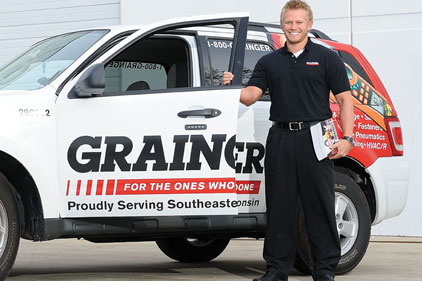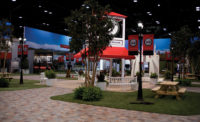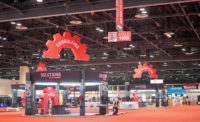Go to www.grainger.com and on the homepage you’ll find several references to industrial safety. On the day in early April when we went to the site, Workplace Eye Wellness Month was featured, with a “Learn more” click for “tips and tools for injury prevention and response.” Beneath the heading, “Online resources to help you create a safe, sustainable and compliant workplace” a button icon for “safety” promises “All the products and resources that help you keep your facility safe and in compliance.” Click the “Shop Safety” link and you enter Grainger’s online world of safety.
Grainger’s online safety content includes product categories for confined spaces, ergonomics, personal protective equipment, slips, trips and falls, heat stress, machine guarding, medical and first aid, health hazards, cold stress, electrical safety, facility safety, and OSHA’s Top Ten Most Cited Violations, starting with respiratory protection and lockout-tagout. Free webinars can be viewed on both topics, and “quick tip” links describe respirator fit testing requirements, respirator selection requirements of substance-specific standards, and a summary of OSHA’s lockout-tagout standard that concludes with commonly asked questions.
Safety products are top sellers
This safety specificity comes from an 87-year-old global company with $9.4 billion in sales with an inventory of more than one million maintenance, repair and operating (MRO) products, more than two million customers around the globe, and 4,479 field sales representatives (about 3,000 are in the U.S.). In 2013, safety and security was Grainger’s top product category by sales, accounting for 18 percent of all global sales. Material handling products were number two and metalworking products number three.
Grainger does not break out annual sales figures by product category, Joseph Micucci, director of media relations, told ISHN’s For Distributors Only. But do some rough math (18 percent of $9.4 billion) and it’s likely Grainger does about $1.5 billion annually in safety product sales.
“Five years ago we started getting aggressive about safety services,” said Grainger Chairman, President and CEO Jim Ryan, a 33-three veteran of the company, at a press conference at the sprawling 2014 Grainger Show held at the Orange County Convention Center in Orlando, FL. “We were getting more and more demands from our customers for safety services. It’s being driven by legislation, more focus on OSHA compliance, and more companies realizing the ‘real cost’ of running an unsafe operating environment. Companies are trying to get costs out of their businesses anywhere and everywhere, and they look at safety to help drive costs out.”
The generalist- specialist hybrid
Can a huge MRO general distributor be a specialist in industrial safety? Ryan has little doubt. “I believe we can be a specialist in the safety segment with value-added services and also play in the broad line business. There is a blurring of the specialist and the generalist today; it is a hybrid business model.”
Grainger’s safety knowledge – in addition to its more than 100,000 safety products — is aided immensely by the experts and resources it acquired when it purchased Lab Safety Supply (LSS) in Janesville, WI, in 1992. LSS operated as a stand-alone division until being merged with Grainger operations in 2008.
Grainger’s technical support center for safety is still located in Janesville, drawing on a staff of 30 safety experts and a huge library of safety guides, tip sheets, white papers and technical articles.
“Their collective résumé up there is really impressive,” said Nino Granatiero, vice president, safety, for Grainger, in an exclusive interview with For Distributors Only. “That staff is tremendous. There are a group of people in Janesville with OSHA 30-hour and 10-hour course training; a number of them have taken the Qualified Safety Sales Professional course, and a few are Certified Safety Professionals (CSPs).
Granatiero joined Grainger in June, 2013 after more than two decades working on the manufacturer side of the safety industry. “I was attracted by Grainger’s commitment to safety, to be the complete safety solution source,” he said. He echoes the words of CEO Ryan: “The reason for (Grainger’s) bigger push into the safety space is that our customers are asking for more of us in safety. They are saying, ‘We want more than products. Do our training, do our risk assessments. Help us solve our safety problems’.”
Acquiring Safety Solutions
Granatiero oversees 20 field safety specialists to back up its thousands of front-line generalist field sales reps. In December, 2013, Grainger announced the acquisition of safety distributor Safety Solutions, based in Dublin, Ohio. Safety Solutions had sales of $63 million in 2012, specialized in an on-site safety footwear service, and carried 20 field sales reps specializing in safety.
“We are integrating them into our team,” said Granatiero. “That will double our field safety specialist presence in the field. I’d love to see that number double or triple over time, it depends on business conditions. You can safely say we plan to increase our safety expertise in the field.”
One of the jobs of the field safety specialists is to support the thousands of field sales generalists. “Our sales force, our front-line sellers, is getting more safety savvy,” said Granatiero. “We want our field sales reps to be comfortable enough to have conversations about safety with customers, and to know when to bring in back up. That could be our safety specialists; it could be our supplier partners.”
Granatiero likens Grainger’s field reps to a general contractor. “We give our reps insight into the businesses they’re visiting so they can initiate a general business discussion. Then when the customer talks about specific safety problems, our sales guys know where to go to get expertise. It’s like a general contractor goes in, talks to a homeowner, learns what the needs are, and then the GC will bring in experts, maybe a plumber, an electrician, and so on.”
Managing safety from a computer
One product that Grainger’s sales force is getting more knowledgeable about, said Granatiero, is Grainger’s three-year-old Online SafetyManager® Safety Management System. The system offers subscribers (via one-year subscriptions) safety audits, checklists, safety meeting materials, written program templates, hundreds of online training courses and training tracking, 4.5 million safety data sheets, OSHA injury and illness tracking, document sharing and tracking, a searchable OSHA database, FAQs, and the ability to phone in and “Ask a Specialist.” A one-year subscription costs $599, with the price going down as a customer orders more subscriptions or “seats” for his organization.
Grainger will not divulge how many subscribers the system currently has, but Granatiero said “year to date in 2014 the number is going through the roof. We are marketing it better. Our sales people are getting better at understanding it and explaining it. Our customers are doing more online training as well as using other online tools to a greater extent. Renewals are really going up, that’s the proof point. Customers are satisfied with the product enough to renew their subscriptions.”
Grainger must stay on top of tech advances to meet Granatiero’s goal of being “the customer’s first and only choice” for safety products and services. In 2012 Grainger introduced a free mobile app for iPhone and Android smart phones to provide instant access to its inventory of products. Grainger also offers an iPad app.
“Today’s technology gives customers quicker and easier access to relevant content,” said Granatiero. “I remember when it used to be you relied on whipping out the NIOSH Pocket Guide, and God forbid if you didn’t have the literature or information in the truck.
“Now from the Grainger safety app customers can get grainger.com white papers, etc. Our field safety sales support specialists bring out their iPads when visiting a customer and take pictures onsite for risk assessment and analysis when they get back to the office. Technology is not taking the safety professional’s job away, it is not like there are safety robots out there. The bottom line for customers is technology allows them to get information quicker.”
Goodbye to transactional selling
Technology is changing the way safety is practiced, but to Granatiero the bottom line is something more humane – trust. “We aren’t at a customer’s site to just sell safety widgets, we don’t want to be transactional, we want to be consultative,” he said. “Selling safety products is different than selling widgets. These are life-saving products in many cases. As a product provider we have to be trustworthy to get to that point where we are the customer’s first and only choice for safety products and expertise. After you factor in service, price, inventory, in safety sales there must be that trust factor.”




